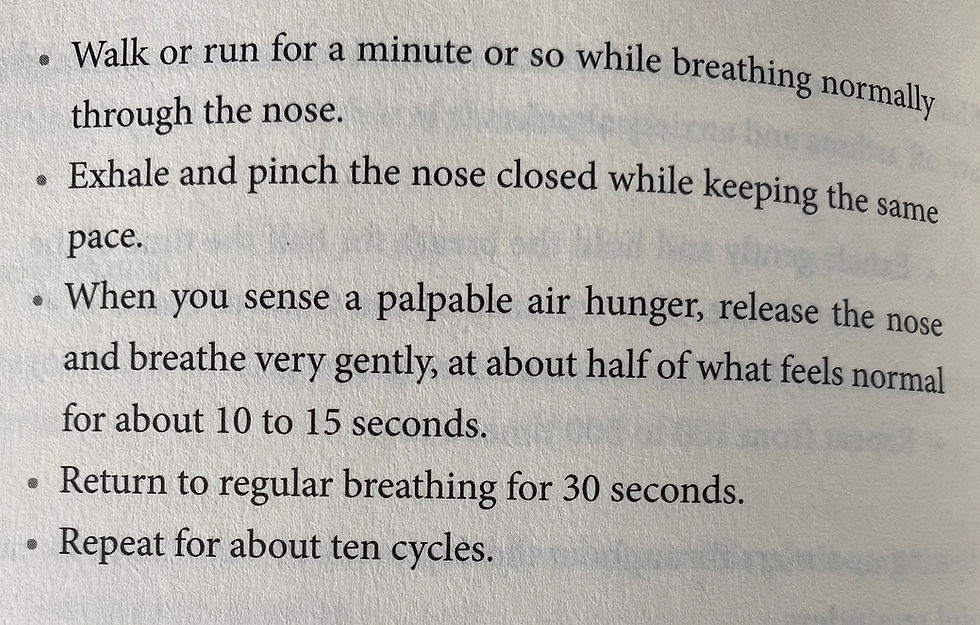Listening to 5 minutes of his interview on NPR made me very intrigued on what was this breathing technique that in 15 minutes of his trying for the first time had him feel better than he had in a long time.
The above fact along with another memory that came to me; the memory of my yoga instructor telling us that we humans use only 10-20% of our lung’s capacity to breathe. Imagine what would happen if we increased that % to double: 20-40 or maybe even more?
It was time. Time to read the book Breath- The new science of a lost art, by James Nestor.
I don’t think you need to read it to learn that breathing is important, it is a rather well written book but I found myself trying to skip ahead to get to one line summaries of how we can breathe better.
You will benefit from reading the last chapter of his book where he summarizes the various breathing techniques and better breathing concepts he introduces throughout the book. Luckily, James provides a link for that in this last chapter and lucky for you, I provide that for you here as well.
The various breathing techniques he describes are:
1. Nadi shodhana (alternate nostril breathing). It’s explained in both the 7th & 9th video on his link.
2. Breathing coordinationwww.breathingcoordination.ch/training.

3. Resonant (coherent) breathing. It’s basically breathing in (inhale) counting up to 5, followed by breathing out (exhale) counting up to 5. It’s video #1 in Jame’s link. In addition, google has a browser app to help with that.
4. Buteyko breathing: It’s the 3rd video on his link. I personally prefer this one where the concept is being explained to a little girl. This technique is named after the founder and involves holding the breath to decongest the nose and also stresses on breathing through the nose to open the nasal passage.
5. Control pause: It’s a diagnostic tool to gauge general respiratory health and breathing progress.

6. Mini breath-holds: Along with Buteyko breathing that suggests breath holding, this practice suggests breathing less all the time. It’s been used with benefits by practitioners to stave off asthma and anxiety attacks.

7. Nose songs: Humming increases the release of Nitric Oxide in the nasal passage 15-fold. This is good for breathing. All you have to do is breathe normally through the nose and hum; any song or any sound for about 5 minutes.
The yogic equivalent technique to this is called Brahmari (meaning bee) pranayama because the sound you make reminds one of a bee. Here’s a 30 sec video of it.
8. Breathe better through walk/run cycles:

9. Decongesting the nose:

You can also watch video #5 from the above list.
6. Tummo breathing: Promoted by Wim Hof, this uses breathing to create heat in our body which kills all bad cells. Check out video #6 in Jame’s links. There is a 20 minute meditation available here as well.
7. Sudarshan Kriya: A powerful yet difficult technique to learn. It consists of 4 phases: Om chants, breath restrictions, paced breathing (inhale 4,hold 4,exhale 6, hold 2) and 40 minutes of very heavy breathing. Try this link to learn a bit more about the technique or go to their primary source. It’s now referred to as SKY (Sudarshan Kriya Yoga) Breath Meditation.
8. Yogic breathing:


This is a good link too as an introduction to pranayama. It's the 8th video in Jame's helpful links.
Conclusion
And if you can’t be bothered to remember all these techniques or if you wanted the book summed up in 6 action items you can remember and do every single day that would make you breathe better and therefore feel better would be:
Shut your mouth, especially while sleeping. In other words, put a tape on it.
Breathe through the nose, all the time.
Take deeper exhales. Check out Carl Stough’s thoughts on this.
Chew more. Chew gum such as Falim Gum. It helps build new bone which helps breathing.
To fall asleep, try the following technique which is something I have been practising and can vouch for its efficiency. It’s called 4-7-8 breathing and is the 2nd video in Jame’s list.
To reduce stress, practice deep/abdominal breathing. Watch how it’s done here, the 4th video in the suggested watchlist. Or try box breathing. It’s called that because you are creating a visual box of breathe in 4 counts, hold 4 counts, breathe out 4 counts, hold 4 counts.

Comments